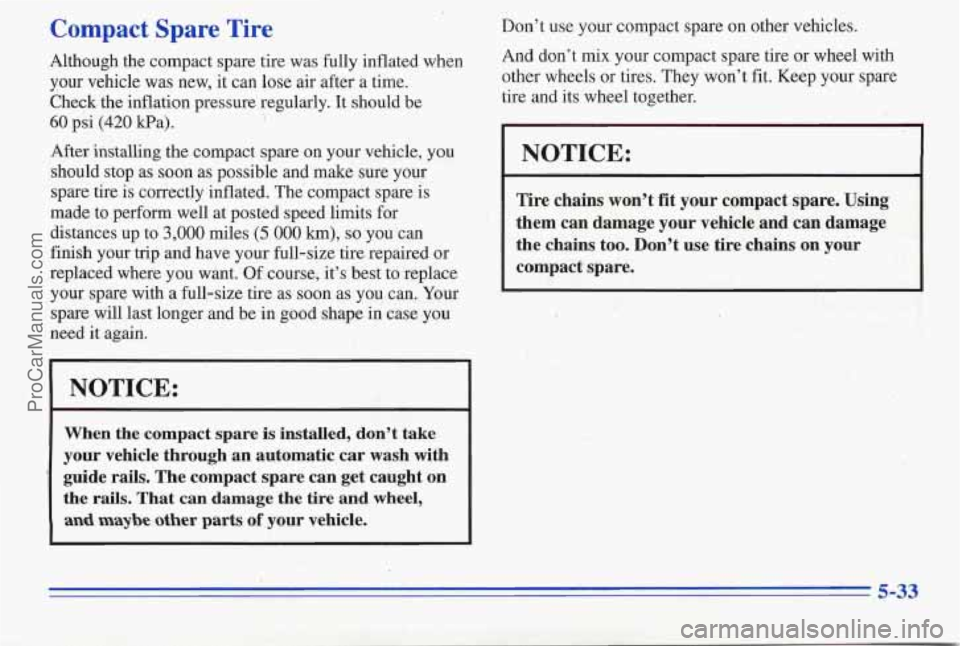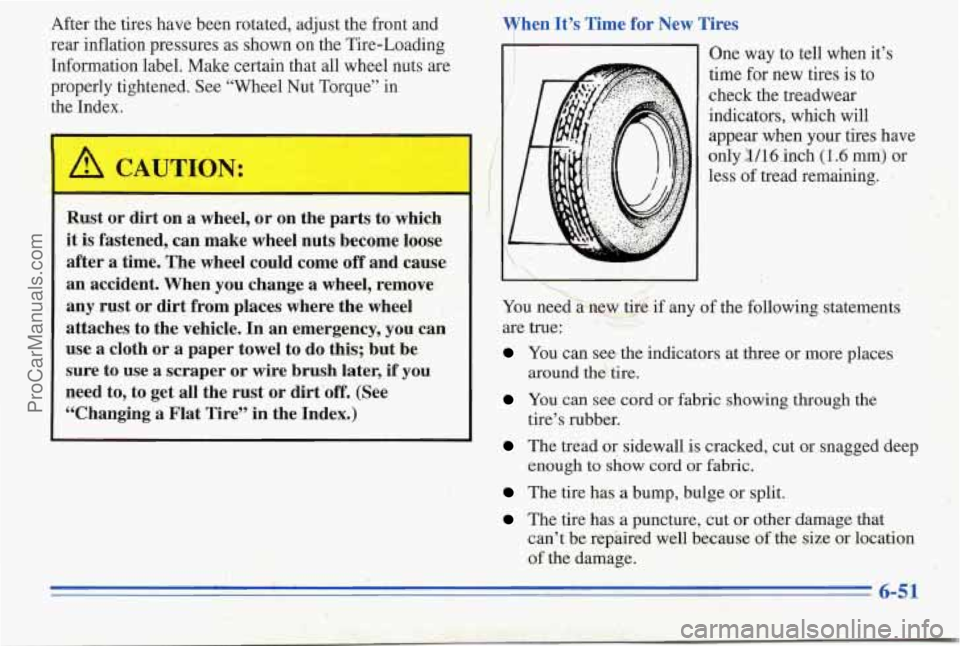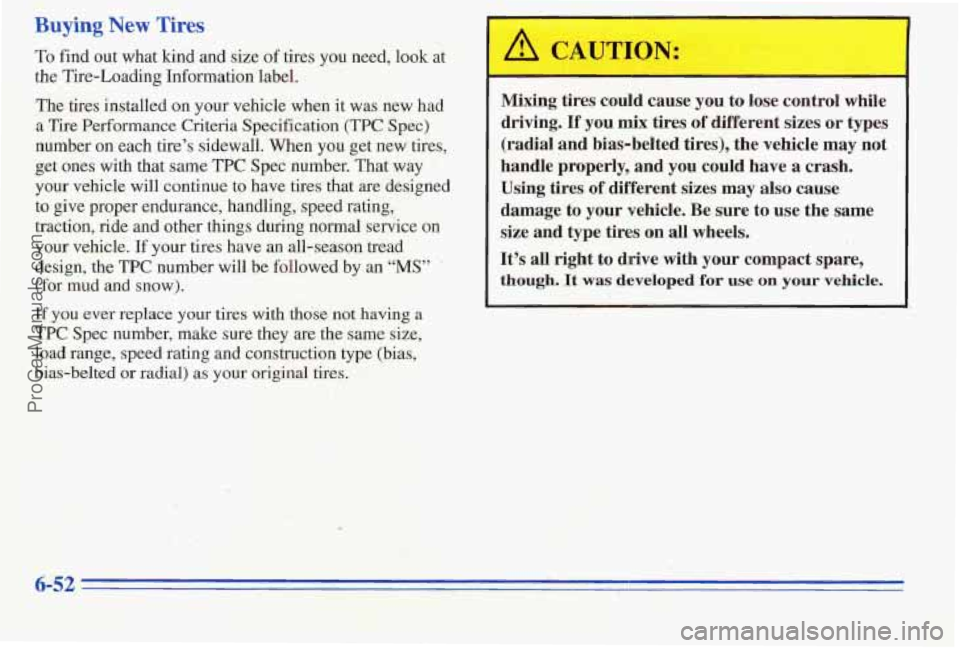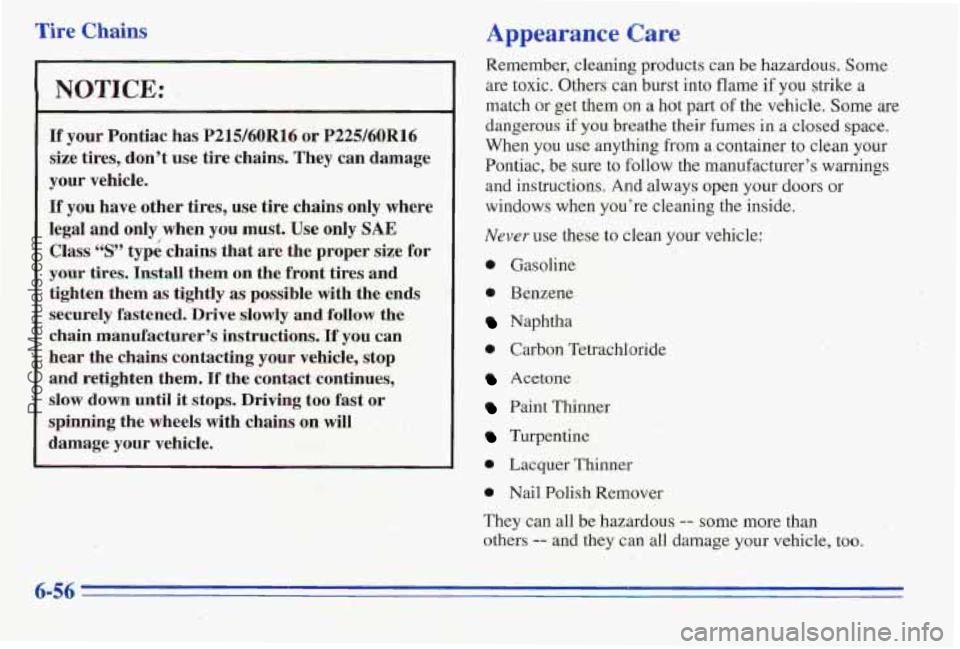Page 224 of 370
Storing the Flat Tire and Tools
Storing a jack, a tire or other equipment in the passenger compartment
of the vehicle could
cause injury.
In a sudden stop or collision, loose
equipment could strike someone. Store all these
in the proper place.
After you’ve put the compact spare tire on your vehicle,
you’ll need to store the flat tire in your trunk. Use the
following procedure to secure the flat tire in the trunk.
Put the flat tire in the trunk so the side that faces out
when it is on the vehicle is facing down. The full-size
tire will not fit down into the well. Place it
so the front is
in the well and the rear is out
of the well.
I
Put the bolt through one of the wheel nut holes, install
the retainer over the bolt, then install the wing nut. Put
the spacer and nut next to the tire in the well. Store the
cover as far forward as possible.
5-31
ProCarManuals.com
Page 226 of 370

Compact Spare Tire
Although the compact spare tire was fully inflated when
your vehicle was new, it can lose air after a time.
Check, the inflation pressure regularly. It should be
60 psi (420 kPa). ’
After installing the compact spare on your vehicle, you
should stop as soon as possible and make sure your
spare tire
is correctly inflated. The compact spare is
made to perform well at posted speed limits for
distances up to
3,000 miles (5 000 km), so you can
finish your trip and have your full-size
tire repaired or
replaced where you want.
Of course, it’s best to replace
your spare with
a full-size tire as soon as you can. Your
spare will last longer and be in good shape in case you
need
it again.
NOTICE:
When the compact spare is installed, don’t take
your vehicle through an automatic car wash with
’ guide rails. The compact spare can get caught on
the rails. That can damage the
tire and wheel,
and maybe other parts of your vehicle.
Don’t use your compact spare on other vehicles.
And don’t mix your compact spare tire or wheel with
other wheels or tires. They won’t fit. Keep your spare
tire and its wheel together.
NOTICE:
Tire chains won’t fit your compact spare. Using
them can damage your vehicle.and can damage
the chains
too. Don’t use tire chains on your
compact spare.
5-33
ProCarManuals.com
Page 278 of 370

After the tires have been rotated, adjust the front and
rear inflation pressures as shown on the Tire-Loading
Information label. Make certain that all wheel nuts are
properly tightened. See “Wheel Nut Torque” in
the Index.
Rust or dirt on a wheel, or on the parts to-which
it is fastened, can make wheel nuts become loose
after a time. The wheel could come
off and cause
an accident. When you change a wheel, remove
any rust or dirt from places where the wheel
attaches to the vehicle. In an emergency, you can
use a cloth or
a paper towel to do this; but be
sure to use a scraper or wire brush later,
if you
need to, to get all the rust or dirt ‘off. (See
“Changing a Flat Tire” in the Index.)
/ I
I 1 I
Then It’s Time for New Tires
One way to tell when it’s
time for new tires is to
check the treadwear
indicators, which will
appear when your tires have
only
11/16 inch (I .6 mm) or
less of tread remaining.
ll.
You needknwt.re if any of the following statements
are true:
You can see. the indicators at three or more places
You can see cord or fabric showing through the
The tread or sidewall is cracked, cut or snagged deep
~~
around the tire.
tire’s rubber.
6,’ . 1. ‘ 1 enough to show cord or fabric. -. . . ..
;C I ., The tire has a bump, bulge or split.
-1 P. The tire has a puncture, cut or other damage that
can’t be repaired well because
of the size or location
of the damage.
6-51
ProCarManuals.com
Page 279 of 370

Buying New Tires
To find out what lund and size of tires you need, look at
the Tire-Loading Information.labe1.
The tires installed on your vehicle w
a Tire Performance Criteria Specification ("PC Spec)
number on each .tire's sidewall. When you get
new tires,
get ones with that same
TPC Spec number. That way
your vehicle will continue to have tires that are designed
to give proper endurance, handling, speed rating,
traction, ride and other things during normal sen;ice on
your vehicle.
If your tires have an all-season tread
design, the
TPC number will be followed by an "MS" '
(for mud and snow).
If you ever replace your tires with tho'se not having a
TPC Spec number, make sure they are the same size,
load range, speed rating and construction type (bias,
bias-belted or radial) as your original tires.
Mixing tires could cause you to lose control while
driving.
If ,you mix tires of different sizes or types
(radial and bias-belted tires), the vehicle may not
handle properly, and you could have
a crash.
Using tires
of different sizes may also cause
damage to your vehicle. Be sure to use the same
size and type tires
on all wheels. ,( ' . ; I :* ' '.i i.!;:; i
It's all right to drive with your compact spare,
though. It was developed for use on your vehicle.
.. i- 4 . .. .-
6-52
ProCarManuals.com
Page 283 of 370

r Eire Chai-n,
-
NOTICE:
If your Pontiac has P215/60R16 or P225/60R16
size tires, don’t use tire chains. They can damage
your vehicle.
If you have other tires, me tire chains only where
legal and only when
yon must. Use only SAE
Class 44S’9 typd. chains that are the proper size for
your tires.
Instau them on the front tires and
tighten them
as tightly as possible with the en&
securely fastened. Drive
slowly and fonow the
chain manufacturer’s instructions. If you can
hear the chains contacting your vehicle, stop
and retighten them,
If the contact contimes,
slow down until it stops. Driving too fast or
spinning the wheels with chains on will
damage your vehicle.
Appearance Care
Remember, cleaning products can be hazardous. Some
are toxic, Others can burst into flame
if you strike a
match or get
them on a hot part of the vehicle. Some are
dangerous if
you breathe their fumes in a closed space.
When you use anything
from a container to clean your
Pontiac, be sure to follow the manufacturer’s warnings
and instructions. And always open your
doors or
windows when you’re cleaning the inside.
Never use these to clean your vehicle:
0 Gasoline
0 Benzene
Naphtha
0 Carbon Tetrachloride
Acetone
Paint Thinner
Turpentine
9 Lacquer Thinner
0 Nail Polish Remover
They can all be hazardous
- some more than
others
-- and they can all damage your vehicle, too.
ProCarManuals.com